|
THOMAS HART - MAJOR ROBERT ROGERS
|
Commander in
Chief of Indians in
the Back Settlements
of America |
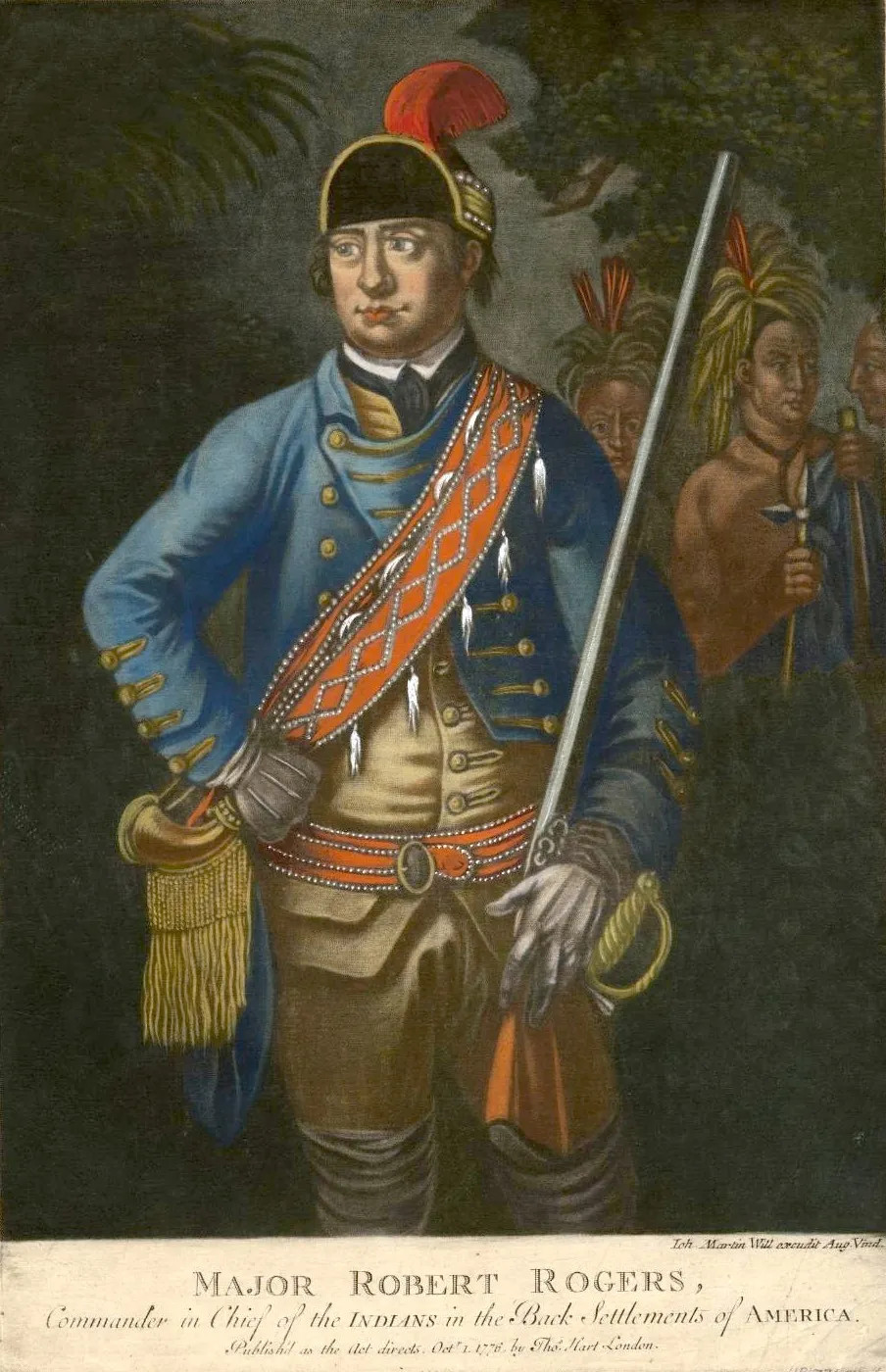
Thomas Hart - Anne S
K Brown Military
Collection
Major
Robert Rogers - Dec
1 1776 |
- Color mezzotint of a representation by Johann Martin Will of Robert Rogers 1776 Queens Rangers published by Thomas Hart.
- Commander in Chief of Indians in the Back Settlements of
America.
- This was one of publisher Thomas Hart's
'mysterious mezzotints' that didn't look like the person,
except there really doesn't seem to be any existing portraits
of Rogers.
- Robert Rogers adopted scouting and ranging techniques that blended military practices
used by the Scottish border patrols in Britain with Native American Indian tactics and woodcraft.
- Known as Wobomagonda (white devil) among the Abenakis, the frontierman gave birth to what was known then as
'ranging' warfare, in Rogers Rangers, a scratch unit that had American Indians as well as freedmen in its ranks.
|
One of the key figures in the historically abhorrent but no less entertaining AMC series Turn, portrayed by Angus Macfadyen, was Robert Rogers, the famed irregular whose unit excelled in combat along the frontier during the French and Indian War.
(laststandonzombieisland.com)
|
|
The Tarnished Tale of Robert Rogers |
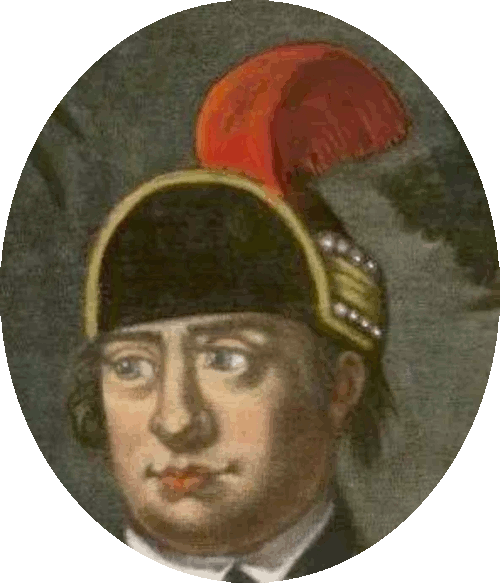
Frontier Commander and Revolutionary Enigma |
- Robert Rogers (1731-1795) was born to Ulster-Scots settlers, James Jacob Rogers and Mary Margaret MacPhartridge on November
7, 1731, in Methuen, a small town in northeastern Massachusetts.
- At that time, the town was a staging point for Scots-Irish settlers bound for the wilderness of New Hampshire.
-
His parents were Scottish Presbyterians from Ulster and reportedly came from Ireland in 1729.
-
Historically, a man named Thomas Rogers (c. 1587–1621), born in London, England, was among the Pilgrim Fathers who sailed on the Mayflower in 1620.
- He died during the first winter at Plymouth Colony, but his son Joseph survived and married, and was later joined in
Massachusetts by his brother John.
|
Robert Rogers’s legacy is one of contradiction and complexity—a Patriot-born Loyalist, a wilderness tactician, and a man whose actions helped shape the fate of one of America’s earliest heroes. His life remains a compelling chapter in the story of a nation divided and forged in conflict.
(familysearch.org)
|

Volunteer |
- In 1739 when Rogers was 8 years old, his family relocated to
the Great Meadow district of New Hampshire near present-day
Concord, however, the newcomers were not left in peace for long.
- In 1744 France declared war on England, and the outlying farms and villages became constant targets for marauding Indians allied to the French.
= In the summer of 1746, at the age of fourteen, Rogers joined the militia
and he signed up again for the 1747 campaign, returning to his family with the winter.
- That following spring, Indian raiders once more cut deep into New Hampshire
and in April they burned the Rogers farm to the ground.
- Though the family escaped, all the cattle were killed, and most of the fruit trees were cut down.
|
At age 14, he volunteered for a local militia and continued serving in militias until he formally volunteered for military service at the beginning of the Seven Years' War in 1755.
(findagrave.com)
|

Freemason |
- He is listed as a Freemason alongside other notable
historical figures.
- Brother Robert Rogers was made a Master Mason at St. John's Lodge No. 1, Portsmouth
in New Hampshire on April 9, 1756.
- He became a member of Zion Lodge No. 1,
in Detroit, Michigan, in 1764 and formed St. John's Lodge No. 15,
in Mackinac Island on November 14, 1784.
- New Hampshire has been reluctant to claim Rogers, who was technically born in Methuen, Massachusetts.
|
He moved with his family to a 2,190-acre wilderness farm near what is now Dunbarton. His father, according to legend, was shot by a neighbor who mistook him for a bear.
(seacoastnh.com)
|
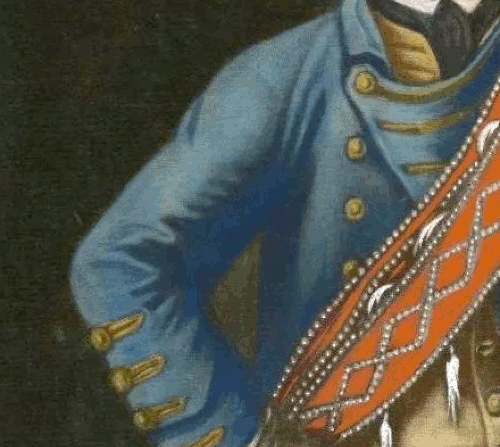
Revolutionary
soldier |
- By the time he was in his early 20s, he was a seasoned frontiersman, over six feet
tall, tough, and thoroughly knowledgeable in the ways of the wilderness.
-
Rogers fought in King George's War (1744–1748), the French and Indian War (1754–1763),
the Seven Year War (1756–1763) and the American Revolutionary War
(1775–1783).
- Robert also had three brothers who served in the Rangers, James Rogers, Richard Rogers and John Rogers.
|
Rogers, instead, codified the "Ranging Rules" and successfully recruited and trained companies of frontiersmen who defended British-held portions of North America in the Hudson River area. Unlike the formal "redcoats", rangers wore green leather uniforms, employed guerilla tactics and were empowered to act independently in battle.
(seacoastnh.com)
|

Indian attacks |
- After patrolling the New Hampshire frontiers the militia was eventually posted to Albany, New York.
- This militia unit operated primarily
in the Lake George and Lake Champlain regions of New York but
later were also deployed in the Great Lakes.
- Their
first objective was the great stone fortress of St. Frederick,
built by the French at the southern end of Lake Champlain (at
Crown Point), a major point for invading Indian war parties.
- By capturing Crown Point the British would dominate Lake Champlain,
striking into the very heart of French Canada.
- In a single successful siege, the British planned to move from the defensive to the offensive in the struggle for North America.
- Rogers was called in when Major General William Johnson
realized his militia was no more capable in the wilderness
than the redcoats.

Well written |
- Rogers’
often made long trips between New England and Canada and the
purpose is not clear, though some historians surmise that he was probably engaged in some aspect of the smuggling trade.
- In any event he enjoyed an easy familiarity with the American wilderness.
- He was also well written, however, there doesn't seem to be
any record of his education.
- Rogers
pioneered guerilla military tactics that are still in use
today specializing in scouting, raids, and ambushes, although
he did not invent the ranger concept.
- Colonists had formally used Indian tactics to repel
Indian attacks as early as the mid-1670s.
|
Young Rogers himself attempted to farm for a while, but between 1743 and 1755, he later declared in his Journals , “my manner of life was such as led me to a general acquaintance both with the British and French settlements in North America, and especially with the unculticated desart, the mountains, valleys, rivers, lakes and several passes that lay between and contiguous to the said settlements.”
(americanheritage.com)
|

Locked and loaded |
- Rangers carried 'a firelock, 60 rounds of powder and ball, and a hatchet' and stood to inspection daily.
- They practiced their marksmanship, which the British saw as a waste of ammunition.
- They were experts at capturing enemy scouts and extracting information by any means necessary.
- Rangers marched in single file to keep one shot from killing two men.
- They were advised not to fire in battle until the enemy was very close, and were invited to disperse and run away if the odds were against them.
|
Gregorian calendar was adopted in England in 1752. That year, Wednesday, September 2, 1752, was followed by Thursday, September 14th, 1752, which caused the country to skip ahead eleven days.
(familysearch.org)
|

Winter raids |
- The militia frequently undertook winter raids against French towns and military emplacements, traveling on sleds, crude snowshoes, and even ice skates across frozen rivers.
-
They were highly effective in the wilderness of North America, using their knowledge of the terrain to raid French supply lines and harass enemy forces.
- Rangers carried their own food separately and could travel by canoe, afoot, on snowshoes and even ice skates.
|
Major Robert Rogers, commander of the Rogers' Rangers during the French and Indian War, who was known for brutal actions, including the potential murder of unarmed women and children. His troops engaged in brutal actions, including scalping enemies and killing unarmed prisoners.
(Assistant)
|

Magnetic personality |
- Rogers, who had a 'magnetic personality,' was made a major and hired by the British to develop
9 companies of men, used largely as scouts.
-
Since he brought more than 50 men in with him, he was promptly commissioned captain and placed in command of Company One.
- A student of Indian warfare, he created one company made up entirely of Native Americans.
- His mission, ultimately, was to obliterate the Abenaki-speaking tribes that had killed hundreds of British pioneers.
- Despite heavy losses, scandal and frequent failure, Rogers Rangers are credited with turning the tide in what Europeans called The Seven Years War.
|
The Seven Years' War began as a North American conflict then stretched between England and France. England, along with allies, battled France in America, India, and Europe, making it arguably the first global war. The conflict ended with the signing of the Treaty of Paris in 1763 and England was victorious. The Seven Years' war ultimately led to discontent in the colonies and the American Revolution.
(familysearch.org)
|

Contingents |
- During the French and Indian War, Rogers raised and commanded Rogers' Rangers, a ranger unit trained for carrying out asymmetric warfare.
- They
quickly expanded to 12 companies, as well as several additional contingents of
Native American Indians who had pledged their allegiance to the British cause.
- The Rangers were kept organizationally distinct from British regulars
and Rogers was their acting commandant, as well as the direct commander of his own company.
- Several forces such as the Queen's York Rangers of the Canadian Army, the U.S.
Army Rangers, and the 1st Battalion 119th Field Artillery all
claim Rogers as their founder.
- Rogers' Standing Orders are still quoted on the first page of the U.S. Army's Ranger handbook.
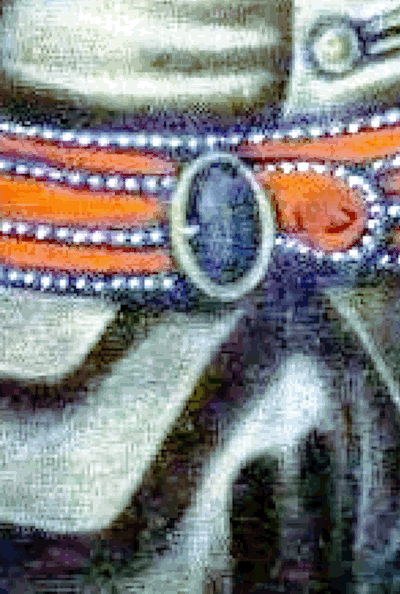
British force |
- Rogers shocked many after joining the British military
during the American Revolution, tarnishing his reputation as a
patriot.
- He had first attempted to join the rebels but
was arrested by George Washington who wouldn't hire him
because he
thought Rogers was a drunkard and a spy, having already proved
himself unreliable.
- So instead, after he escaped
imprisonment by the patriots, he offered his services to the
the British.
- Although Rogers fought for the British, most of his Rangers became patriots.
|
Today re-enactors from Michigan to Oregon to Kentucky and New York still dress in green garb and relive the ranger lifestyle.
(seacoastnh.com)
|

|
|
Major |
- It is unclear exactly what transpired between the revolutionary leaders and Rogers.
- The local Committee of Safety arrested him as a possible spy and
then released him on parole provided he would not serve against the colonies.
- He was offered a commission in the Revolutionary Army by the Continental Congress, but declined on the grounds that he was a British officer.
- Later he wrote to George Washington asking for a command, but instead Washington had him arrested.
-
Rogers escaped from Washington's custody only to find revolutionary ranks firm against him, so he offered his services to the British Army.
|
...the only man I was ever afraid of. (George
Washington)
|

Mohicans |
- Rogers was an Americanized warrior and a product of the
19th-century.
- The same cultural forces that made the Last
of the Mohicans such a literary hit, resurrected Robert Rogers
legacy because he was a woodland fighter who had adopted
tactics from his Native American Indian adversaries.
- Unlike the French,
the British didn't have much Indian support because some of
their defeats caused them to lose prestige and once that
happened, they had a hard time finding Indians to scout for
them.
- There weren't too many volunteers in 1755 because
it was very dangerous business.
|
The Mohican people are an Eastern Algonquian Native American tribe originally from the upper Hudson River Valley of New York, whose name means "the people of the waters that are never still". They are historically related to the Lenape and lived in a region that included present-day Albany, western Massachusetts, and parts of Vermont and Connecticut. (Assistant)
|
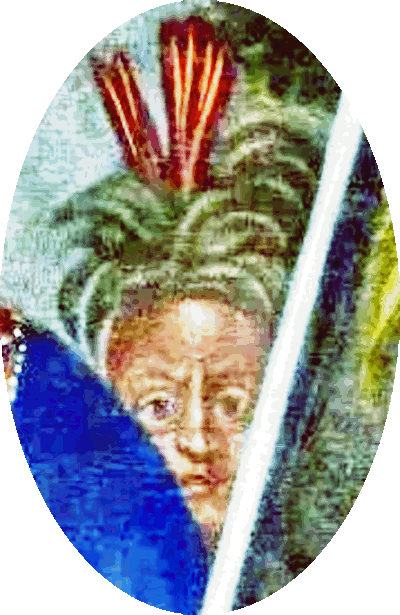
Woodland Indians |
- One of the things that Rogers learned about these
woodland Indians was their ability to have patience, lay low,
and endure.
- He
discovered that the Indian brand of courage was very different
from British and Western courage where you stood up (macho
man, even
where cannonballs were mowing you down and this created a lot
of friction.
- This was very
different, even though you were being tortured, you wouldn't
say a thing and that is courage.
- The British were trained
to fear their commanding officers and fight in tight
formations and they viewed their part as a 'cog' in a machine.
- Rogers epitomized the agressive offensive spirit that was
sorely lacking in the British Army in 1755.
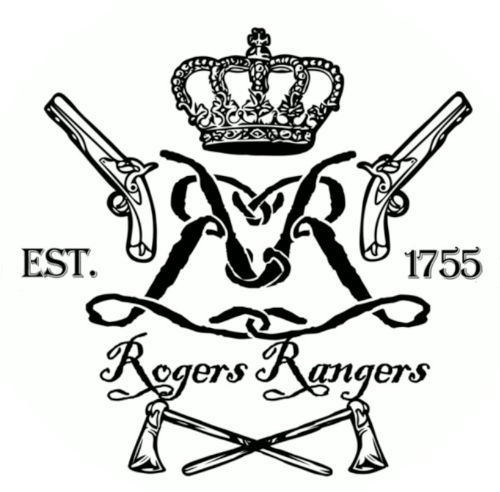
Ranger seal |
- Rogers was one of the
first to sign up to fight in the French and Indian War and he
was a charismatic young leader and he was able to recruit a
lot of his neighbors and was given the rank of captain.
-
Wben he was building his army he took in 'hard-bitten'
Yankees, he had former slaves, and he had Indians that he
promoted to officers in his ranks.
|
Rogers' Rangers were never fully respected by the British regulars, yet they were one of the few non-Indian forces able to operate in the inhospitable region despite harsh winter conditions and mountainous terrain. (Wikipedia)
|

King George's War |
- Rogers
did not invent the ranger idea, which had been around since
the Indian wars of the late 17th-century, but he did codify
the concept with a series of well-thought out 'commandments.'
-
During 1740, the War of the Austrian Succession (1740–1748) broke out in Europe.
- By 1744, the war spread to North America, where it was known
as King George's War (1744–1748) and Rogers served as a private in the New Hampshire militia, gaining early frontier experience.
- Perhaps it was on one of his smuggling ventures through this wilderness that Rogers met a convicted forger named Owen Sullivan.
- Court records show that in January, 1755, Rogers was arrested and imprisoned with
18 others on charges of disbursing counterfeit money printed by Sullivan.
- He was indicted but the case was never brought
to trial.
|
During Rogers' youth (1746), he saw service in the New Hampshire militia as a private in Captain Daniel Ladd's Scouting Company and, in 1747, also as a private in Ebenezer Eastman's Scouting Company, both times guarding the New Hampshire frontier. (Wikipedia)
|

Ranger |
- By 1755, war engulfed the colonies, spreading also to Europe. Britain and France declared war on each other.
- It became very clear to the British soldiers
in the colonies, how different the rough and tough Rogers Rangers were to them.
- The British in America suffered a string of defeats
and encouraged by the French victories, American Indians launched a series of attacks along the colonial frontier.
- In 1756, Rogers arrived in Portsmouth, New Hampshire, and began to muster soldiers for the British Crown, using the authority vested in him by Colonel Winslow.
_1761_by_Joseph_Blackburn.jpg)
Joseph Blackburn, Public domain, via Wikimedia Commons
Elizabeth
'Betsey' Browne
1761 |
- In Portsmouth, he also met his future wife Elizabeth Browne (1741-1813), the youngest daughter of Anglican Reverend Arthur Browne
(1769-1839) and Mary Coxe.
-
The wedding took place on June 30, 1761, when he married the youngest daughter of the influential minister of Queen's Chapel, now St. John's Church.
- She was 20 and Rogers was 29.
- Reverand Arthur Browne was leader of the local Anglican Church,
and was among the city's most powerful men prior to the Revolution.

Ranger
love |
- The Reverand, who had married British Royal Governor Benning Wentworth to his young housekeeper, officiated at his daughter's wedding too.
-
They were the parents of at least 2 sons and 1 daughter.
- The New Hampshire Gazette reported news of the marriage
and from that point they continued to carry all Roger's
doings, however, Portsmouth eventually turned against him.
- The marriage ended in divorce and she married a
second time to Captain John Roche on June 11, 1778.
-
Elizabeth was born on June 29, 1741, in
Portsmouth and died at age 72 on December 11, 1813, in Concord
and was buried in Old North Cemetery.
|
Their separation during his court martial trial is the subject of a ballad by John Greenleaf Whittier appropriately titled "The Ranger." The couple soon moved to Concord, NH (then Rumford) where Elizabeth lived with her enslaved servants. Here Rogers wrote his memoirs and even authored a play. Curiously, Rogers transferred ownership of the Concord house, lands and slaves to Elizabeth's father. She later inherited them. (seacoastnh.com)
|

Upper Hudson |
- Rogers' recruitment drive was well supported by the frightened and angry provincials due to attacks by
Native American Indians along the frontier.
- From 1755 to 1758, Rogers and his
Rangers served under a series of unsuccessful British commanders operating over the northern accesses to the British colonies.
- This included Major General William Johnson, Major General William Shirley, Colonel William Haviland, and Major General James Abercromby.
- At the time, the British could do little more than fight defensive campaigns around Lake Champlain, Crown Point, Ticonderoga, and the upper Hudson.
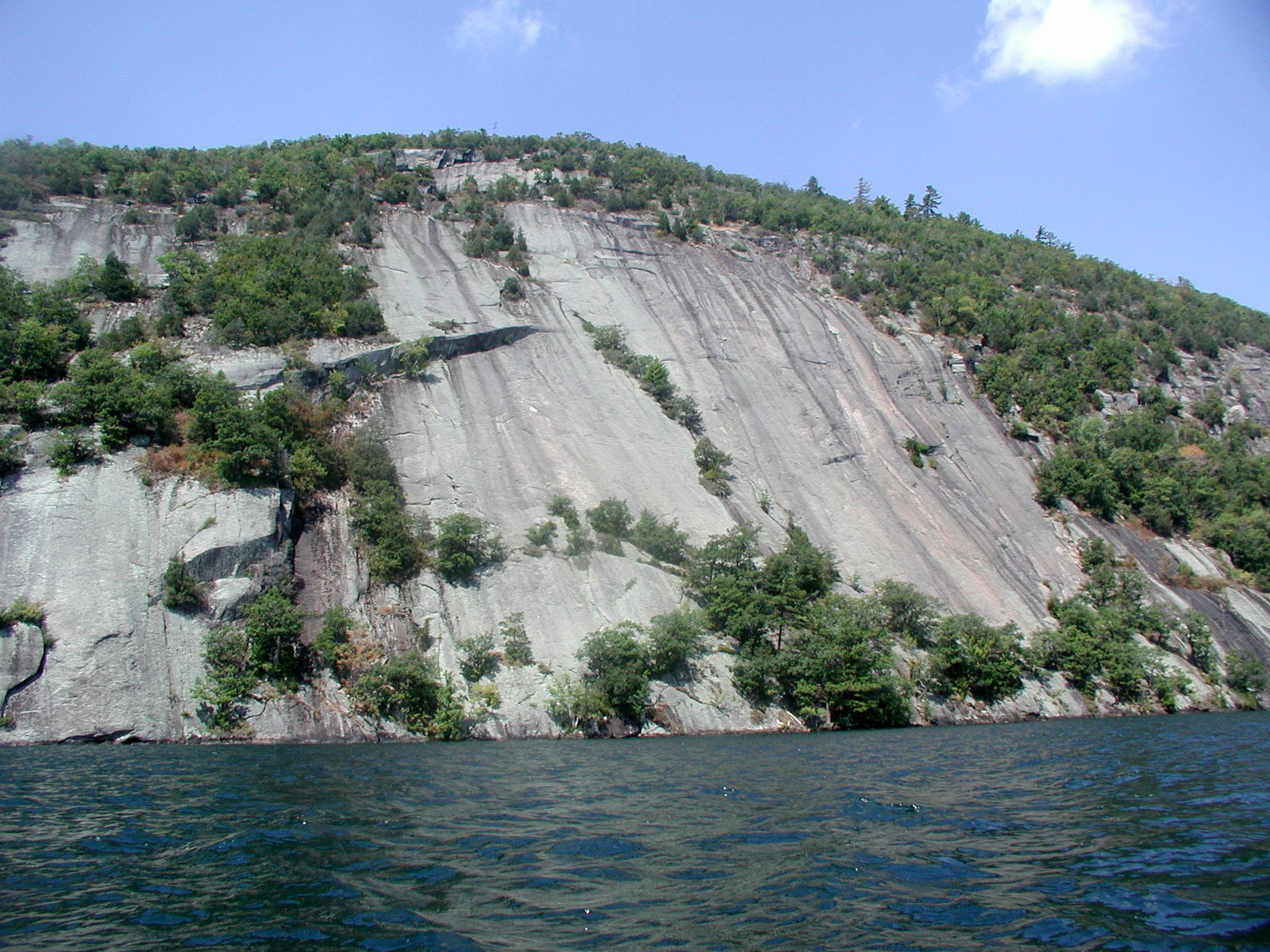 |
|
The southeast face of Rogers Rock, where Captain Rogers supposedly executed his brilliant escape. |
- The 'Great Carry' describes the few miles of land route between the Hudson
River and Lake George, connecting the waterways between New York and Quebec
which was strategic territory during the Revolutionary War.
- In March 1758, Israel Putnam returned to Fort Edward from an uneventful scouting, when Rogers was at once sent out with 180 men on an aggressive mission
to British controlled Fort Carillon (Ticonderoga).
- He proceeded to Lake George and down its ice-covered surface, his scouts in advance on skates.
- Rogers reached the vicinity of the mountain now known as
Rogers' Rock.
|
Roberts' well-researched novel, published in 1936, was largely responsible for reviving the Rogers legend. Among the people credited with assisting the author was Portsmouth librarian Dorothy Vaughan who lived to age 99. (seacoastnh.com)
|

Rogers Slide |
- This is where the story breaks into its different versions.
- One version has Rogers sliding down the face to the ice below and miraculously surviving and escaping pursuit.
- The more accepted story is that Rogers walked up to the edge of the cliff, slid his backpack down to the lake, then walked backward, retracing his snowshoe tracks and scaling a tree.
- Upon discovering the scene, the enemies saw the footprints leading up to the ledge and the slide trail left by the backpack, promptly assumed that Rogers had died, and gave up pursuit.
- Rogers would hike back unscathed.
- As such, the mountain was named Rogers Rock, and that face is called Rogers Slide.

Disastrous |
- From 1757 through 1758, Rogers' Rangers fought in 3 'Battle on Snowshoes' engagements, with the first two being disastrous for the Rangers.
- He entered into the woods west of this mountain, sending a
portion of his force on the frozen surface of Trout Brook equipped with snowshoes.
- While the Rangers were resting, a band of Abenaki warriors
and French soldiers appeared at their rear.
- The Rangers saw them coming and struck first
and the Abenaki fell back after more soldiers arrived from the
fort.

Amherst |
- British morale was at a low ebb when William Pitt became prime minister is 1757.
- Pitt soon grasped the importance of America in Great Britain’s quest for victory over France.
- Soon after, fresh troops, ships, and supplies came streaming over the Atlantic.
- Major General Lord Jeffrey Amherst, methodical and competent, became the new commander in chief for America.
|
St. Francis
Raid |

Wilderness |
- On the evening of September 13, 1759, Rogers and 220 hand-picked rangers climbed into 17 whaleboats and rowed across the placid waters of Lake Champlain.
- The night was dark and a dozen men in each boat worked the oars in two relays, propelling the boats through the water.
- The French schooner La Vigilant and a trio of sloops were constantly on the lookout for British incursions.
- The expedition would row all night, then come ashore to hide in the lake’s marshy rim during the day.
|
The cream of the Abenaki fighting forces joined French militia to wait in ambush for Rogers and his men. (Eric Niderost)
|

Element of surprise |
- The mission was simple on paper, but daunting in execution. Rogers’s rangers were ordered to
'attack the enemy’s settlements on the south side of the river St. Lawrence in such a manner as you may judge most effective.'
- The rangers would have to travel approximately 160 miles through some of the roughest wilderness in North America, yet also escape detection from the French and their
Native American Indian allies in the area.
- They would also have to maintain an element of surprise.

News from the north |
- Robert Rogers stepped forward, suggesting a plan that had been in the back of his mind
for some time, a raid on St. Francis, one of the principal strongholds of the Abenaki
Indians near the St. Lawrence River.
-
Anxious for news from the north, General Amherst dispatched Captain Quinton Kennedy of the 17th Foot
unit to try and get through to other British commanders.
- In
late 1759, not long after his capture of Fort Carillon and
Fort Ticonderoga from the French, Amherst sent Rogers’ Ranger
Kennedy northward carrying a proposal of peace for the
Abenaki, who were loyal to the French.
- Kennedy also
carried secret dispatches to General Wolfe, who was then
besieging the French town of Quebec.
|
One oral tradition suggests that a Stockbridge man
was tortured and killed after he refused to return to
his St. Francis Abenaki wife. The officers were
abused, and Amherst was so incensed that he decided,
as Rogers recalled, “to chastize these savages with
some severity.” (Rod Soodalter)
|
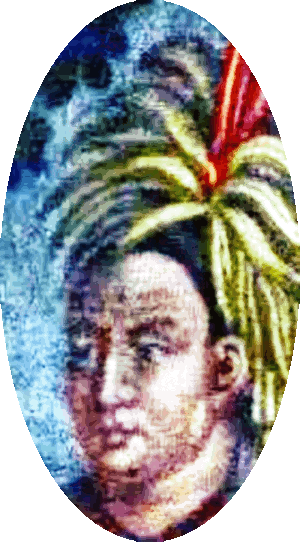
Indian warrior |
- Kennedy’s party included another British officer and several Mohican Stockbridge Indian warriors.
- Abenaki Indian warriors captured Kennedy and all his party but they
were well treated.
- Amherst was furious when he heard of Kennedy’s capture, claiming the officer had been operating under a flag of truce.
-
He was frustrated and ready for revenge and ordered a raid on St. Francis, one of the principal strongholds of the Abenakis.
|
St. Francis—more properly St. François de Sales—was originally established opposite Quebec, but it was relocated near the St. Francis River in 1700. It was a Jesuit mission, and many of the Indians were at least nominal Catholics. (Eric Niderost)
|
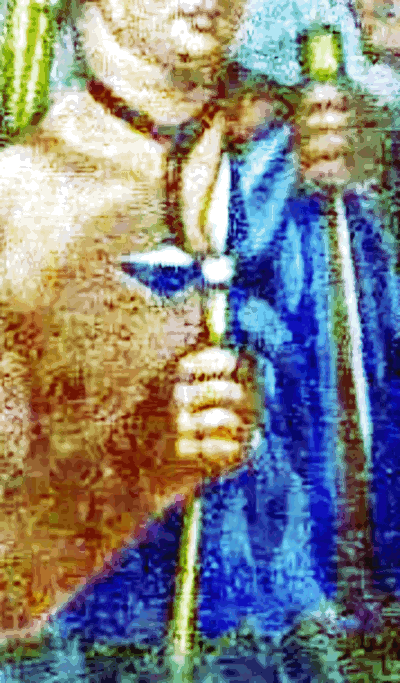
Abenaki
savage |
- In the late 1690s, Jesuit missionaries built a Catholic mission dedicated to Saint Francis there, and
offered the Abenaki people protection under the colony of New France.
- The Jesuits, called the
'Black Robes' because of their clerical garb, were successful because they sanctioned, or at least tolerated, many Indian traditional ways.
- It didn't look like the traditional Indian settlement,
but was a town constructed of wood houses.

Massacred |
- The St. Francis settlement soon developed a reputation for savagery
against the English settlers.
- Raiding parties poured out of St. Francis, attacking English settlements throughout the New England frontier.
- Men, women, and children were massacred and scalped by
the natives and their hair proudly displayed as trophies.
-
Encouraged by the French, they received sixty livres for every scalp.
|
Rogers’s plan for attack was simple but effective. They would pounce on the village in three divisions, converging on the target from the south, east, and north. Amherst’s orders were clear: revenge could be taken, but Indian women and children were to be spared. (Eric Niderost)
|

Leads |
-
The St. Francis raid was an attack in the French and Indian War by Rogers on
the community, near the southern shore of the Saint Lawrence River.
- Major Robert Rogers led a group of 142 English regulars, including officers, volunteers, and
provincial soldiers, north up Lake Champlain towards St. Francis.
- They were accompanied by 24
Mohican Indians from Stockbridge, Massachusetts.
|
On October 3, some Abenaki women washing in the St. Francis
River spotted wood chips floating on the water – oral traditions suggest that these might have
been from rafts or bridges that Rogers’ men built to facilitate crossing the St. Francis River near
what the Abenaki called the “little woods” around St. Joachim.
(Rod
Soodalter)
|

High frolic |
-
The moon was nearly full on October 3, 1759, when Robert Rogers claimed he snuck into the village,
after forming a human chain to cross the swifty moving St.
Francis River.
- There, the Rangers 'found the Indians in a high frolic or dance.'
- During that same night, one of
Rogers’ Stockbridge Mohican scouts delivered a warning about the
impending attack by the Rangers to a young teenaged girl during the dance at the Council House.
- This same scout was later found wounded and asked to be
baptized before the Abenaki's murdered him.
|
Amherst,
commander in chief of British forces in North America,
had defined the mission in deceptively simple terms:
You are this night to set out with the detachment as
ordered yesterday, viz. of 200 men…and proceed to
Misisquey Bay, from whence you will march and attack the enemy’s settlements on the south side of the river St. Lawrence in such a manner as you shall judge most effectual to disgrace the enemy.…Remember the barbarities that have been committed by the enemy’s Indian scoundrels.…Take your revenge, but don’t forget that tho’ those villains have dastardly and promiscuously murdered the women and children of all ages, it is my orders that no women or children are killed or hurt. (Rod
Soodalter)
|

Hel met |
- In the predawn darkness of October 4, 1759,
the assault began at 5 am, an hour before dawn.
- The sleeping village of St. Francis was completely surprised; no sentries had been posted.
- Once inside the village, the Rangers fanned out, entering homes to kill every fighting warrior they could find.
- The assault was risky but resistance was easily overcome.
|
The fire consumed many of the Indians who had concealed themselves in the cellars and
lofts of their houses. About seven o’clock in the morning the affair was completely over, in
which time we had killed at least two hundred Indians, and taken twenty of their women and
children prisoners, fifteen of whom I let go their own way, and five I brought with me, viz.
two Indian boys and three Indian girls. I likewise retook five English captives, which I also
took under my care. (Robert Rogers, Journals of Major Robert Rogers)
|

D anger |
- It felt like a safe place for the Indians, since it had
a Catholic mission under the protection of the French, and was located far to the north of the
English settlements.
- But some of the more traditional elders felt that dependence on European
lifeways was dangerous.
- Another common belief 3 among Abenaki people even
today is that birds, animals, fish, and other non-human
creatures carry important messages.
|
The premonitions about the attack came in various forms. Some elders are said to have had
recurring dreams about English or Mohawk attacks that likely resonated from their experiences
as young children during King Philip’s War (1675-1676), King William’s War (1689-97), Queen
Anne’s War (1702-13), Greylock’s War (also called Dummer’s War, Father Rasle’s War, and
Lovewell's War, 1722-25) King George’s War (1744-48), the French and Indian War (1754-63),
and other conflicts that had forced them to move north. (Rod
Soodalter)
|

White devil |
- Once the last shot was fired., the Rangers put the village to the torch, burning French-style houses and Indian wigwams alike.
-
His troops engaged in brutal actions, including scalping
enemies and killing unarmed prisoners.
- Accounts of the 1759 raid on St. Francis suggest that Rogers and his men murdered women and children, although the historical accounts of this are disputed and heavily edited in his journals.
|
High-pitched screams rose above the crackling flames. For those Indians taking shelter in lofts and cellars, their hiding places had become funeral pyres. (Eric Niderost)
|

Ferocity |
- During the French and Indian wars, Abenaki warriors gained a reputation for ferocity during
their battles against English colonists who were encroaching on Abenaki territory.
- Their
adversaries were New England men who spent most of their lives enmeshed in military conflicts
as the English colonies tried to expand northward, meeting Abenaki resistance every step of the
way.

Trumpet |
- Rogers later claimed that he had killed 200 Indians at St. Francis, but best estimates of the total village population placed it at 500.
- Most of the warriors were away at the time, so the village population must have been smaller.
- The French claimed that around 40 villagers had been killed, most of them women and children.
- This was considered a successful, daring raid on a St. Francis Abenaki village
because it resulted in the village's destruction where some
600 scalps, most of them English, were displayed around the
village on trophy poles.
|
Saint Francis was a polyglot settlement, with people coming and going at all times. English captives could often be seen there, and French-Canadian trappers and hunters frequented the place. Rogers spoke fluent French, so his mere presence would not arouse suspicion. To further conceal his visit, when Rogers arrived, St. Francis was in the midst of a giant celebration, possibly a wedding. (Eric Niderost)
|

Trumpet player |
- Rogers and his men left St. Francis the next day and spent 8
days near starvation on the way back.
- The starving and famished rangers ate everything they could find, including bark, beech leaves and small amphibians.
- Other rangers consumed their belts and shoes, and even boiled their powder horns in a vain quest for nourishment.
- Rogers had to get help because his troops could go no further and he
somehow managed to reach another fort 60 miles away (several
days on horseback) to get
assistance.
|
Lieutenant Samuel Stevens had been dispatched by Amherst with food and supplies, but after waiting a few days, Stevens grew uneasy and returned to Crown Point. Supposedly he saw signs of Rogers’ approach and thought it was the enemy. He missed Rogers and the rangers by two hours. (Eric Niderost)
|

Brutal attack |
- The St. Francis raid took them deep into Abenaki
territory in Quebec and during the
disastrous return journey, as Rogers’ men were hotly pursued by Abenaki and French fighters, he
split up the company and 43 rangers, more than half of his remaining men. died of wounds or
starvation.
- In Abenaki traditions, the resort to cannibalism is an atrocious act that signals a terrible
transformation out of human form.
- Traditional stories contain warnings about cannibal giants
and other spirits that might harm the unwary
|
In desperation, some of the raiders
cannibalized their own dead. One Abenaki captive, Marie-Jeanne Gill, was killed and eaten by
the rangers during the retreat, according to the diary of Lieutenant George Campbell, who wrote:
"Ye Chef’s wife expired & may have been kill’d by ye Stockbridges. Ye Major has asked me
not to reveal this probability that Jenkins Stockbridges kill’d ye Chefs Squaw." (Rod
Soodalter)
|
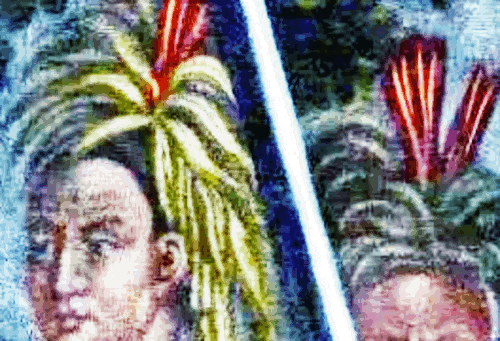
Northwest Passage |
- The attack on St. Francis is recognized as an important event in American
history, but most people only know the fictional version.
- The movie Northwest Passage
portrays half-naked savages, living in teepee's and pounding on great war drums.
-
Filmed just before America entered World War II, the movie is a thinly disguised recruitment poster.
- Ebenezer Webster of East Kingston, future father of statesman Daniel Webster, is among the Rangers portrayed in the book version of
Northwest Passage by Kenneth Roberts.
|
Drafted into Rogers’ elite force, often compared to the modern Green Berets, Langdon and Hunk overcome impossible odds, defeat the French, and return safely home, Imbued with patriotism. Stopping back in Portsmouth in the final scene of the film, Rogers bravely returns to the battlefront, a symbol of the indomitable American spirit. (seacoastnh.com)
|

Brave |
- Town histories
depict the Abenaki as violent foreign marauders, who attacked no reason, conveniently forgetting
to mention the broken treaties and boundary violations of English settlers in Abenaki territory.
- Some historians have even claimed the Abenaki were engaged in a drunken orgy the night before the
raid.
|
The St. Francis River
was known to the Abenaki as Arsikantegouk or Alsigontekw (meaning “empty cabin river” or
“place of shells”), a name that recalled both a 1691 Mohawk attack and a 1700 plague. (Marge Bruchac)
|
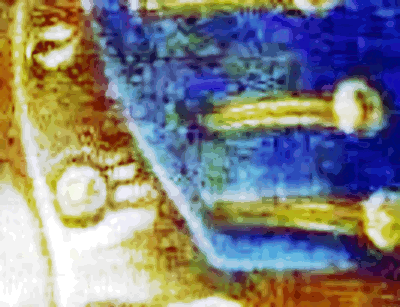
Biased reports |
- Many of the well-documented historical details preserved in Abenaki oral traditions and French
written records are unfamiliar to Americans.
- There has been much
indoctrination and many biased
accounts of colonial soldiers, and the stereotypes and errors in the writings of later historians.
- The historians who have compared English, French, and
Abenaki records now generally agree that Rogers exaggerated
the success of his raid, and inflated the numbers of the
Abenaki dead, in large part to cover his own losses.
|
The French and Abenaki records agree that only 32 Abenaki people actually died during the raid, among them 10 men and 22 women and children who were burned in their homes or shot while trying to escape. (Rod
Soodalter)
|

Recovered |
- Rogers also recovered 3 young girls who had been
kidnapped
by the Abenaki years earlier, but 2 of them died of smallpox in Albany.
-
The remaining girl had been captured 5 years earlier and was
reunited with family after one of Roger's Native American
Rangers recognized her.

Post-Montreal
Campaign |
- Next came the Post-Montreal Campaign that began in 1760
after Montreal fell to the British.
- Rogers' Rangers were tasked with taking control of French forts along the Great Lakes, including Fort Michilimackinac and Fort St. Joseph.
-
The Rangers played a key role in Major General Jeffery Amherst's successful 1760 campaign that led to the capture of Montreal and the end of major hostilities in North America.
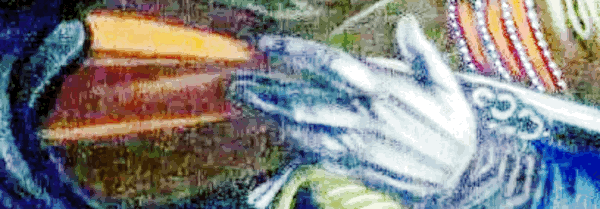
Pontiac's Rebellion |
- During Pontiac's Rebellion in 1763,
Rogers rejoined General Amherst and the British army to fight against Native American tribes.
-
Rogers and his men covered the British retreat during the Battle of Bloody Run while attempting to break Pontiac's siege of Fort Detroit.

Commander of the
rangers |
- Rogers was personally responsible for paying his soldiers, and he went deeply into debt and took loans to ensure that they were paid properly after their regular pay was raided during transport.
- He was never compensated by the British Army or
government.
- Rogers had brought total dedication to his position as commander of the
Rangers.
- As was often the custom in the British and American armies, he had spent his own money to equip them when needed and consequently had gone into debt.
- In 1764, he was faced with the problem of repaying his creditors.
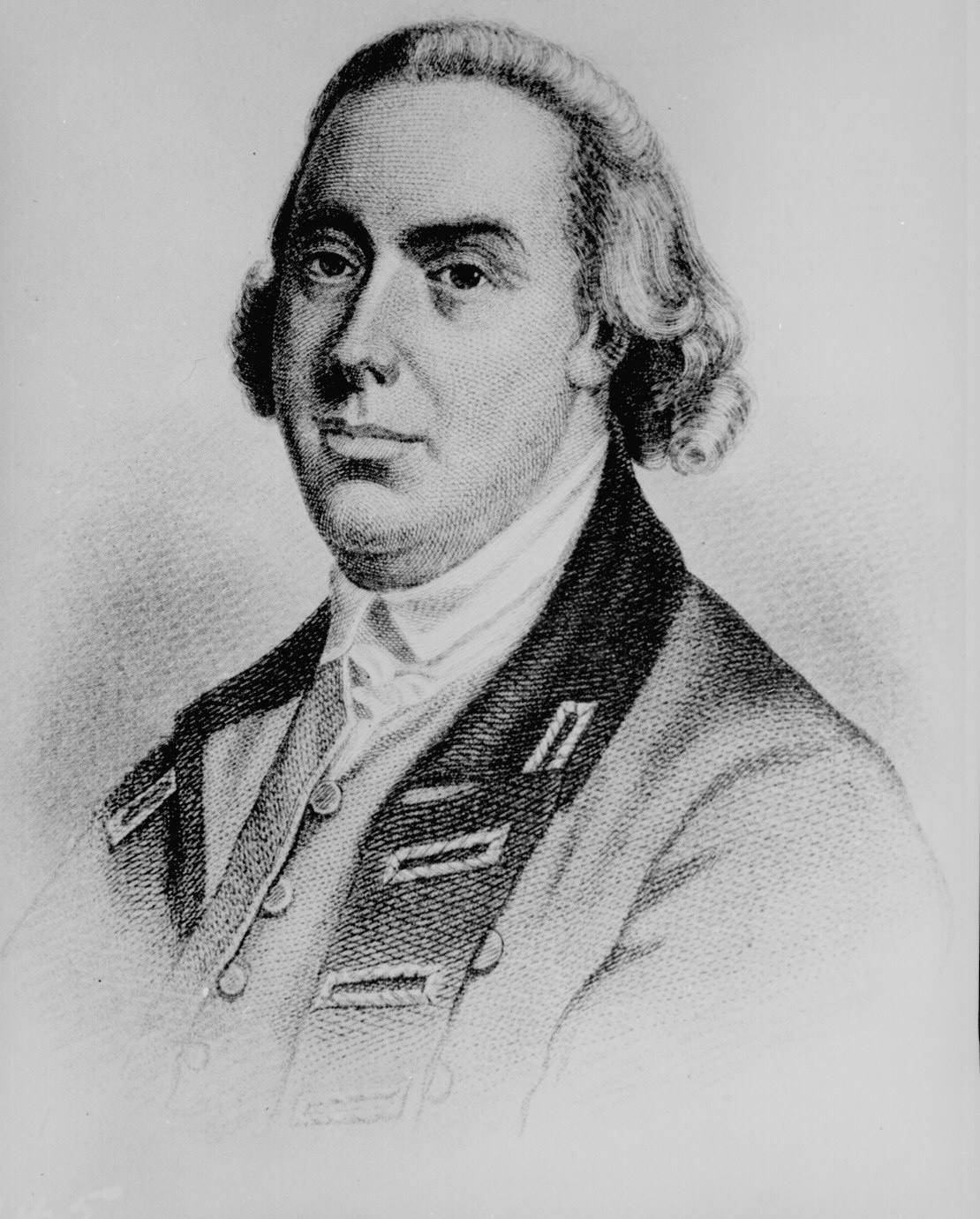
Public domain, via Wikimedia Commons
General Thomas Gage
|
- British General Thomas Gage bitterly disliked Rogers due to his close friendship with
General Jeffrey Amherst, Gage's rival.
- As an aristocrat and political intriguer, Gage viewed Rogers as a provincial upstart who posed a threat to his newly acquired power, due to his friendship with Amherst.
- Rogers won appointment as Royal Governor of Michilimackinac in the newly won territory of the Great Lakes.
- The biggest problem for Gage, though, was that Rogers had ambitions of setting up a government that would report directly to the King, not through Gage.

Turncoat |
- Additionally, he purportedly talked of giving the territory over to the
French if he din’t get his way.
- This did seem to
be becoming a habit of his, threatening to turn on his
commanders if he didn't get his way, a temper tantrum.
- At the time, Rogers was still a half-pay captain in the British army and, to some degree, under Gage's military jurisdiction.
- However, Gage could not challenge Rogers, the king's appointee, unless he could find a good reason, as the king would countermand any legal process in order to save his favorites.
|
He is wild, vain, of little understanding, and of as little Principle; but withal has a share of Cunning, no Modesty or veracity and sticks at Nothing . . . He deserved Some Notice for his Bravery and readiness on Service and if they had put him on whole Pay. to give him an Income to live upon, they would have done well. But, this employment he is most unfit for, and withal speaks no Indian Language. He made a great deal of money during the War, which was squandered in Vanity and Gaming. and is some Thousands in Debt here [in New York]. (Gage
letter to Indian Superintendent Sir William Johnson)
|
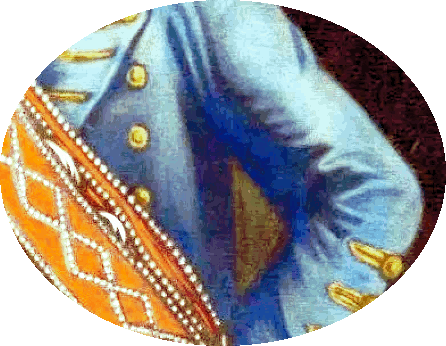
Captain |
- Knowing this, Gage actively set about finding a solid justification to remove Rogers as royal governor in a way that would forestall royal intervention.
- Gage used every opportunity to defame Rogers, portraying him as an opportunist who had gotten rich on the war only to gamble away his money as a profligate.
- It is difficult to say how many of these allegations were true and how much Gage believed them to be true.
|
Unaware of Gage's plotting, Rogers continued performing his administrative duties with considerable zest. He dispatched expeditions to search for the fabled Northwest Passage under Jonathan Carver and James Tute, but they were unsuccessful. (Wikipedia)
|

Wounded by Gage |
- Gage apparently saw Rogers as of questionable loyalty, certainly he was not loyal to Gage, and therefore he needed watching.
- Rogers' dealings with the American Indians troubled Gage, as he and many other British officers in America had come to regard the Indians with great suspicion.
- Gage hired spies to intercept Rogers' mail and suborned his
subordinates.
- Rogers offended Gage's private secretary, Nathaniel Potter, who subsequently gave Gage the excuse that he needed.
- Potter swore in an affidavit that Rogers had said that he would offer his province to the French if the British authorities failed to approve his method of governance.
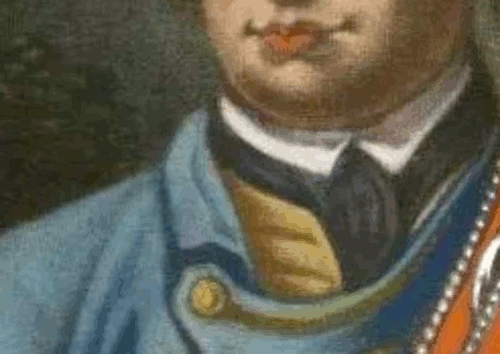
Arrested |
- Rogers was arrested in 1767, charged with treason, and taken to Montreal in chains for trial,
however, the trial was postponed until 1768.
- Gage had sent Rogers to Montreal to stand trial but, once there, Rogers was among friends of
General Amherst.
- Due to Amherst's influence, Rogers was acquitted of all charges and the verdict was sent to King George III for approval.
- The king approved, but could not call Gage a liar openly,
so instead, he made a note that there was reason to think Rogers might have been treasonous,
but the episode further tainted his reputation.

|
|
Suffering |
- Rogers went to debtors' prison and tried suing Gage for false imprisonment.
- Gage settled out of court by offering Rogers the half-pay of a major in return for dropping the suit.
-
Due to all his legal troubles in England, Robert Rogers missed the major events in the
revolting colonies.
- After hearing that revolution was likely to break out,
he returned to America in 1775.
- At that time, Rogers was perhaps suffering from the alcoholism that blighted his later life and led to the loss of his family, land, money, and friends.
- Unreimbursed expenses put enormous pressure on more than one officer of the era, as Benedict Arnold and George Rogers Clark could attest.
- And the resentment and rivalry of powerful men was dangerous.
|
The Americans were as out of touch with Rogers as he was with them, looking upon him as the noted ranger leader and expecting him to behave as one; they were at a total loss to explain his drunken and licentious behavior. (Wikipedia)
|
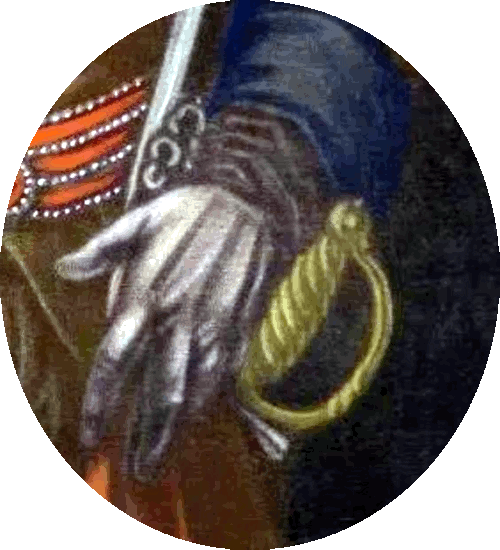
British officer’s
commission |
-
Robert Rogers was a defacto loyalist and in 1775 he still nominally held a British officer’s commission.
- He tried to win an appointment from Washington but was spurned in 1776.
- Infuriated, Rogers joined the British cause, forming and
commanding the loyalist regiment the Queen's Rangers and later
the King's Rangers.

Nathan Hale |
-
In September 1776, Rogers assisted in the capture of American Nathan Hale
who was spying on the British for the Continental Army.
-
That was the zenith of his Revolutionary War career.
- In May 1777, the British Army forcibly retired Rogers on grounds of
'poor health.'
- A return home now was impossible; Hale's execution and Rogers raising troops against the colonials seemed to confirm Washington's suspicions.

Elizabeth |
-
In 1777 the frigate Ranger, originally a privateer named
The Portsmouth left Portsmouth Harbor en route to its famous raid against England.
- The ship's figurehead depicted a colonial ranger holding his rifle.
- The following year, in 1778, Elizabeth petitioned the New Hampshire General Assembly for a divorce from her husband on the grounds of Desertion and infidelity.
- Ironically, Elizabeth then married Captain John Roche the man who had originally been chosen to command
Ranger.
- Roche, also rumored to be a heavy drinker and a man of untrustworthy character, was replaced aboard Ranger by an ambitious young mariner named John Paul Jones.
- Jones sailed Ranger into history even as Robert Rogers was commanding the Queen’s Rangers against his own homeland.
|
At Washington's prompting, the New Hampshire
legislature passed two decrees regarding Rogers: one a
proscription, and the other a divorce from his wife on
grounds of abandonment and infidelity. She could not
afford any friendship or mercy toward Robert now if
she expected to remain in New Hampshire. Later,
Elizabeth married American naval officer John Roche. (Wikipedia)
|

|
|
Retired |
-
After a brief sojourn in England, Rogers returned in 1779 to raise the King's Rangers in Nova Scotia for General Sir Henry Clinton.
- He was unable to keep the position due to his alcoholism, so his place was taken by his brother James
and Rogers played no further part in the war.
- The Queen’s Rangers, led at the time by the unremarkable Major James Wemyss was decimated at Brandywine when used as traditional infantry, leading the unit to be resurrected by John Graves Simcoe.
- After the war, the Rangers were sent to Canada and quietly disbanded.
|
As noted by the British Army today, “After the loss of the North American colonies, the British Army lacked a forested frontier where it could usefully employ a ranger unit and the capability ceased to exist in its pure form,” with later “Ranger” units such as the Central London Rangers, The Connaught Rangers, The Royal Irish Rangers, and The Sherwood Rangers Yeomanry, holding the name as more of an honorific title than as descriptor for a force designed for a specialist ranger role, or that they used unconventional tactics.
(laststandonzombieisland.com)
|
 |
|
Imprisoned |
- Rogers was captured by an American privateer and spent some time in a prison in New York, escaping in 1782.
- In 1783, he was evacuated with other British troops to England,
where, he was unable to earn a living, nor was he able to defeat his alcoholism.
- Rogers. 63, died in obscurity and debt on May 18, 1795,
in Newington, London Borough of Southwark, Greater London, England/
- What little money he had going to pay an arrears in rent.
- He was buried in London in St. Mary's Churchyard but his gravesite has been lost.
|
Certainly many of Rogers’ wounds were self-inflicted; had he been able to get a handle on his drinking, he would likely have managed an honorable career in the American Revolution and a reasonably comfortable retirement.
But it is also true that he was badly treated, buffeted by bad fortune and ill-will that seemed to dog him from about 1763 onward. (frontierpartisans.com)
|
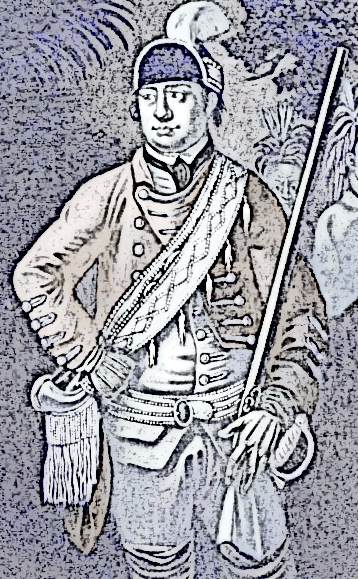 |
|
Statue of Rogers |
- On May 30, 2005, Memorial Day in the U.S., a statue of Rogers was unveiled during a ceremony on Rogers Island in the Hudson River, 40 miles north of Albany, New York.
- This is near to the site where Rogers penned his
Rules of Ranging.
- Camp Rogers, on the eastern edge of Fort Benning, is the location of the Ranger Assessment Phase of U.S. Army Ranger School, and the headquarters compound for the United States Army Airborne and Ranger Training Brigade.
- Robert Rogers: Hero or Monster? He is a troubling hero.
- His 28 Ranger Rules continue to shape
special forces but his life ended in poverty, shrouded
in mystery.
|
Whether Robert Rogers was a hero is a complex question, as he is often viewed as both a revolutionary military figure and a deeply flawed individual. However, his legacy is tarnished by his financial ruin, alcoholism, and his choice to fight for the British Crown during the American Revolution.
(Assistant)
|
|
Meanwhile, impatient to mount and ride,
Booted and spurred, with a heavy stride
On the opposite shore walked Paul Revere.
Henry Wadsworth Longfellow

|

